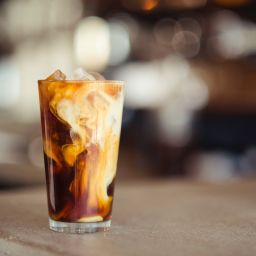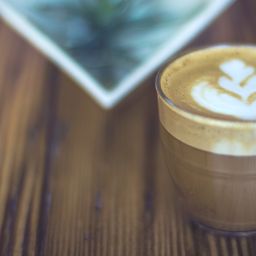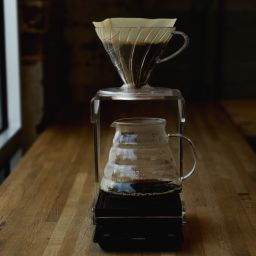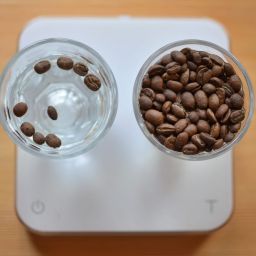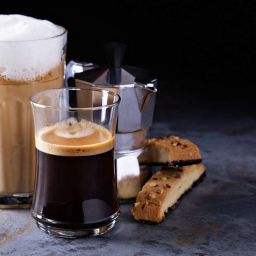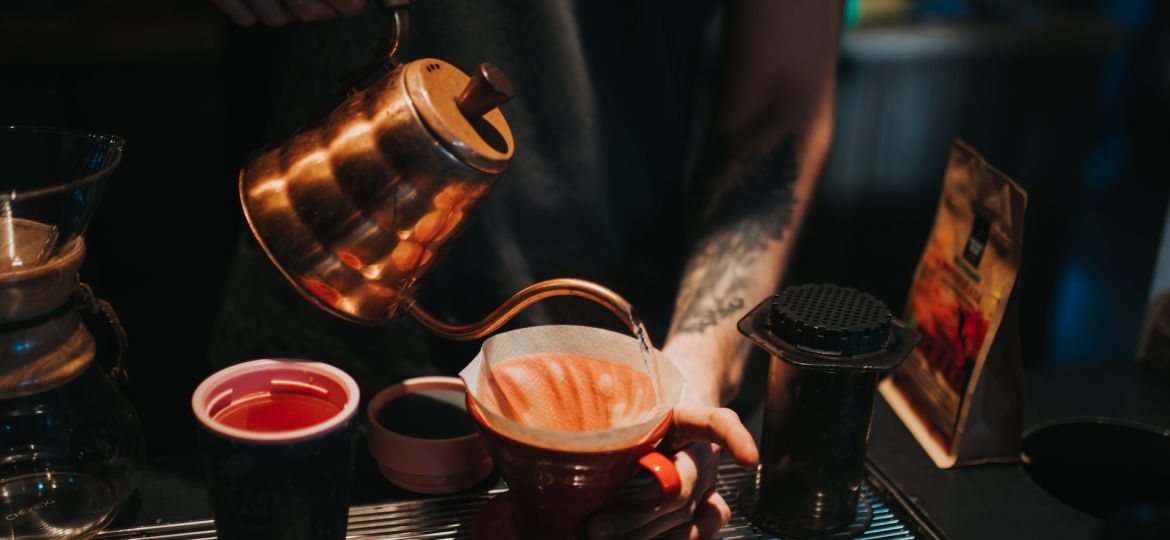
Pourover coffee isn’t just a drink; it’s an experience. This brewing method has a rich history, tracing back to early 20th-century Germany. It gained popularity for its simplicity and the exceptional flavor it extracts from the coffee beans. Today, it’s a favorite among coffee aficionados worldwide, celebrated for its ability to highlight intricate flavors and aromas that other brewing methods often miss.
Essential Equipment for Pourover Coffee
To dive into the world of pourover, you’ll need a few key pieces of equipment:
- Choosing the right dripper: The heart of the pourover method is the dripper. Two popular choices are the Kalita Wave and the Hario V60. The Kalita Wave is known for its flat-bottom design, ensuring even extraction, while the Hario V60, with its conical shape, requires a bit more skill but rewards you with a cup full of nuanced flavors.
- Importance of a good grinder: A consistent grind is crucial. Burr grinders are preferred over blade grinders as they provide uniform coffee grounds, which is key for a balanced extraction.
- Selecting the best kettle and scale: A gooseneck kettle offers control over pouring speed and direction, which is vital for the pourover method. A scale ensures the right coffee-to-water ratio, essential for that perfect cup.
Selecting Coffee Beans
The choice of beans can make or break your pourover experience:
- Types of beans suitable for pourover: Look for high-quality, single-origin beans. They tend to have distinct flavor profiles that pourover brewing can accentuate.
- Impact of roast profiles on flavor: Light to medium roasts are ideal for pourover. They retain the unique characteristics of the bean and its origin. Dark roasts can be too overpowering and might mask the subtle flavors that pourover is known for.
Pourover coffee is more than just a brewing method; it’s a craft. With the right equipment and a bit of practice, you can unlock a world of flavors that’ll change the way you think about coffee. Remember, it’s all about the process and the enjoyment that comes with it.
The Brewing Process
Brewing the perfect cup of pourover coffee might seem like a bit of a ritual, but trust me, it’s worth every second. Here’s a step-by-step guide to get you started:
- Heat your water: Aim for a temperature between 195°F and 205°F. If you don’t have a thermometer, just let boiling water sit for about 30 seconds.
- Grind your beans: You’re looking for a medium to medium-fine grind – something akin to sea salt. Consistency is key here, so a good burr grinder is your best friend.
- Prep your filter and dripper: Place the filter in the dripper and rinse it with hot water. This gets rid of any papery taste and warms up your dripper.
- Add your coffee: Place the dripper over your cup or carafe and add the ground coffee. A good starting point is a 1:16 coffee-to-water ratio. For example, use 25 grams of coffee to 400 grams of water.
- Bloom your coffee: Pour just enough water to saturate the grounds and let it sit for 30 seconds. This allows the coffee to “bloom” and release gases, leading to a better extraction.
- The pour: Start pouring the rest of your water in a slow, steady spiral, starting from the center and moving outwards. Take your time and enjoy the process.
A few key points to remember:
- Water temperature is crucial. Too hot, and you’ll burn your coffee; too cool, and you won’t extract enough flavor.
- Grinding size and consistency matter. A uniform grind ensures even extraction.
And there you have it! With a bit of practice, you’ll be brewing pourover coffee like a pro in no time. Remember, it’s all about finding what works best for you and your taste buds.
Advanced Techniques and Tips
Once you’ve got the basics down, it’s time to fine-tune your pourover game. Here are some advanced techniques and tips to help you brew like a seasoned barista:
Pouring Techniques for Even Extraction
- Start with the bloom: Pour just enough water to wet the grounds and wait for about 30 seconds. This lets the coffee degas and ensures a more even extraction.
- Go slow and steady: Pour in a slow, steady spiral, starting from the center and moving outward. The goal is to keep the water flow consistent.
- Control the pour: Use a gooseneck kettle for better control. The speed and direction of your pour can significantly affect the extraction.
Adjusting Variables for Flavor Refinement
- Experiment with water temperature: Slightly cooler water can bring out the brightness in lighter roasts, while hotter water can extract more from darker roasts.
- Adjust the grind size: If your coffee tastes too bitter, try a coarser grind. If it’s too sour, go finer.
- Play with the coffee-to-water ratio: More coffee will result in a stronger brew, while less coffee makes it weaker. Find the balance that tastes right for you.
The key to mastering pourover is experimentation. Don’t be afraid to tweak these variables until you find your perfect cup.
Cleaning and Maintenance
To keep your pourover gear in top shape and your coffee tasting great, follow these cleaning and maintenance tips:
- Regular rinsing: Rinse your dripper and carafe with hot water after each use.
- Deep clean occasionally: Use a coffee equipment cleaner or a mix of vinegar and water for a deeper clean every few weeks.
- Descale your kettle: If you have hard water, descale your kettle regularly to prevent mineral buildup.
Common Mistakes to Avoid
- Neglecting cleanliness: Coffee oils can build up and go rancid, affecting the taste of your brew.
- Using the wrong grind size: This can lead to over or under-extraction.
- Ignoring water quality: Good quality, filtered water can make a big difference in taste.
Proper maintenance not only prolongs the life of your equipment but also ensures consistently delicious coffee.
A little care goes a long way in the world of coffee brewing!
FAQs
Pourover coffee might seem daunting at first, but it’s actually pretty straightforward once you get the hang of it. Let’s tackle some common questions and clear up any confusion:
- How much coffee should I use? A good starting point is a 1:16 coffee-to-water ratio. For every gram of coffee, use 16 grams of water. Feel free to adjust to your taste.
- What’s the best grind size for pourover? Aim for a medium to medium-fine grind, similar to sea salt. Consistency is key.
- Can I use regular tap water? Water quality matters. Filtered water is recommended for a cleaner, better-tasting brew.
Tips for Beginners
- Start simple: Don’t get overwhelmed. Begin with basic equipment and upgrade as you go.
- Be patient: Good coffee takes time. Enjoy the process and don’t rush it.
- Practice makes perfect: Your first few tries might not be perfect, and that’s okay. Keep practicing!
Troubleshooting Common Issues
- Coffee tastes bitter: This could be due to over-extraction. Try a coarser grind or shorter brew time.
- Coffee tastes sour: This is often a sign of under-extraction. Go for a finer grind or longer brew time.
- Uneven flavor: Make sure you’re pouring evenly and your grind size is consistent.
Every cup is a learning experience. Don’t be afraid to experiment and adjust based on your taste preferences.
Summarizing the Art of Pourover Coffee
Pourover coffee is more than just a brewing method; it’s a craft that combines precision, patience, and a bit of personal flair. Here’s a quick recap:
- Get the right gear: A good dripper, grinder, kettle, and scale are your best friends.
- Pay attention to details: Water temperature, grind size, and pouring technique all play a crucial role.
- Experiment and enjoy: Each cup is an opportunity to refine your skills and discover new flavors.
The beauty of pourover coffee lies in its simplicity and the personal touch you bring to each cup. So, grab your kettle, find your favorite beans, and start brewing. Who knows what delicious possibilities you’ll uncover?


